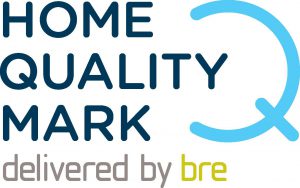Implementing Active Design Principles using BREEAM Domestic Schemes and the Home Quality Mark
HQM and BREEAM Refurbishment: Domestic are schemes which holistically address the environmental, social and economic impacts of a home

How can The Home Quality Mark Contribute to Active Design?
Assessment Issues with a Strong Contribution
1.2 Sustainable transport options
Awards credits for transport infrastructure that can promote less private car travel and more active transport including consultation with local authority to improve cycle networks.
Aligns with Active Design Principles 2 & 3.
1.3 Local amenities
Credits are awarded for the presents of key local amenities such as supermarkets and banks which are within walking distance as well as amenities within 1.5 miles or 30 minutes by public transport as well as other amenities which are beneficial to the community such as recreational grounds.
Aligns with Active Design Principles 2 & 4.
2.5 Recreational space
Credits are give which recognise the different types of space which promote community spirit, activity and wellbeing. Includes credits for access to: public recreational space, private space, communal space and space for growing fruit and vegetables.
Aligns with Active Design Principles 1, 5 & 7.
5.3 Impact on local air quality
Credits are awarded for home which have hot water or heating systems which have minimal impact on the air quality in the area.
Aligns with Active Design Principles 1, 2 & 6.
Assessment Issues with a Moderate Contribution
2.4 Long term ecological management & maintenance
Credits are awarded for the ongoing management and maintenance of ecological features.
Aligns with Active Design Principle 9.
11.4 Post occupancy Evaluation
Credits are awarded which recognise where POEs will be carried out to evaluate the actual satisfaction levels with various aspects of the home/community including features that contribute to active communities: public transport, sustainable transport options, cycling storage/networks, local community overall, local amenities, air quality, outdoor space.
Aligns with Active Design Principle 9.
Assessment Issues with a Minor Contribution
2.1 Identifying ecological risk and opportunity
This issue contributes to improving ecological value of the site, including provision of greenspace and habitat creation/enhancement. ‘Wider site sustainability’ criteria also considers ways to achieve multiple sustainability/ecosystem service benefits
Aligns with Active Design Principle 5.
2.2 Managing impacts on ecology
This issue implements plans agreed in issue 2.1, protecting ecology during site preparation and construction, minimising negative loss as far as possible.
Aligns with Active Design Principle 5.
2.3 Ecological change and enhancement
This issue recognises biodiversity net gain which is contributed by ecological enhancement and creation.
Aligns with Active Design Principle 5.
3.2 Managing rainfall
Credits are awarded where there are management plans in place for SuDS
Aligns with Active Design Principles 5 & 9.
7.2 Access and space
Credits are awarded for internal space that is accessible to all and supports the function of the home. Accessibility within the home supports access to outdoors and connectivity with wider area.
Aligns with Active Design Principle 8.

BREEAM Domestic Refurbishment is the Certification standard for homes undergoing refurbishment, rennovations or new extensions.
The standard assesses the process of the refurbishment, its mangement and the environemntal, social and economic impacts it will have on the occupants.
How can BREEAM Domestic Refurbishment Contribute to Active Design?
Assessment Issues with a Strong Contribution
Energy 09: Cycle Storage
Credits are awarded where there is appropriate cycle storage which can empower occupants to cycle from their home.
Aligns with Active Design Principles 7 & 8.
Assessment Issues with a Minor Contribution
Management 05: Protection and Enhancement of Ecological Features
Awards credits for protection of ecological features and for enhancement which can create attactiveness and visual diversity hence increasing likelihood of people using the site for activity.
Aligns with Active Design Principle 5.
Health and Wellbeing 04: Inclusive Design
Credits are awarded for recognising internal space that is accessible to all and
supports the function of the building. Accessibility within the building supports access to outdoors and connectivity with wider area.
Aligns with Active Design Principle 8.



